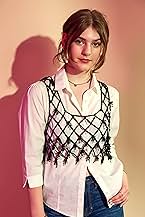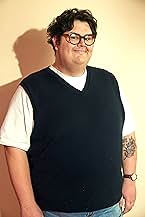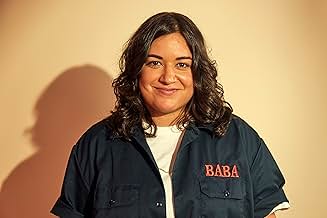VALUTAZIONE IMDb
6,4/10
4133
LA TUA VALUTAZIONE
Sam, una cabarettista alle prese con il disturbo da stress post-traumatico, valuta se partecipare o meno alla ricerca di un'adolescente scomparsa a cui faceva la babysitter.Sam, una cabarettista alle prese con il disturbo da stress post-traumatico, valuta se partecipare o meno alla ricerca di un'adolescente scomparsa a cui faceva la babysitter.Sam, una cabarettista alle prese con il disturbo da stress post-traumatico, valuta se partecipare o meno alla ricerca di un'adolescente scomparsa a cui faceva la babysitter.
- Regia
- Sceneggiatura
- Star
- Premi
- 8 candidature totali
Recensioni in evidenza
As a person who has also experienced trauma, I've often wondered - how would I ever approach writing a book or movie about my experiences, and honestly the way this movie used flashbacks did resonate with me.
I can understand how some might feel it's disjointed, but honestly that's sometimes how living with PTSD, depression, etc. Feels like.
I know some people complained that it's not funny, I guess I didn't expect it to be laugh out loud funny based on the description - it literally includes PTSD in the description and is called "I used to be funny" - i.e. She doesn't feel funny anymore.
Overall, I appreciated the storytelling.
I can understand how some might feel it's disjointed, but honestly that's sometimes how living with PTSD, depression, etc. Feels like.
I know some people complained that it's not funny, I guess I didn't expect it to be laugh out loud funny based on the description - it literally includes PTSD in the description and is called "I used to be funny" - i.e. She doesn't feel funny anymore.
Overall, I appreciated the storytelling.
"I Used to Be Funny" is a captivating Canadian film that masterfully weaves together raw, heartbreaking moments with a surprising touch of humor. Rachel Sennott's performance shines yet again, reaffirming my unwavering admiration for her talent. As both the lead and a true force on screen, Sennott's portrayal effortlessly captures the complexities of the character's journey.
Ally Pankiw's directorial debut is stellar, showcasing a deep understanding of the human experience. While not flawless, the film's imperfections only add to its authenticity. Pankiw's skillful storytelling draws viewers into the protagonist's world, offering an accurate depiction of life with PTSD. The film's ability to blend these elements in a way that's both poignant and relatable makes it a must-see for anyone seeking a moving cinematic experience.
Ally Pankiw's directorial debut is stellar, showcasing a deep understanding of the human experience. While not flawless, the film's imperfections only add to its authenticity. Pankiw's skillful storytelling draws viewers into the protagonist's world, offering an accurate depiction of life with PTSD. The film's ability to blend these elements in a way that's both poignant and relatable makes it a must-see for anyone seeking a moving cinematic experience.
Powerful message and subject in this movie but the journey its a little tiresome, there is no real history here, its a basic movie, the protagonist is amazing but the rest of the cast are not very good in this, they are rookies I guess, they are not the best actors in here tbh, the way the story is told is kinda of make no sense just like this review, it's convoluted and not easy to follow but maybe im slow i don't know, the protagonist is a very funny stand up comedy artist and she is fighting some demons in this movie, and that's a very interesting thing to follow but the way its told through flashbacks it wasn't really neccesary, its hard to understand ok guys.
Comedy is inherent in calling on personal experiences for a joke. Humor is a defense mechanism and a willing tool to break the ice and even recover. Comedy is healing and is used significantly in the film I Used To Be Funny. In a somewhat dark comedy set against the backdrop of the #MeToo era, the film stars Rachel Sennott as a struggling comic battling PTSD who takes part in a search for a missing girl she used to nanny. The film tackles heavy subject matter with airy deftness, and what ties it together is Sennott's arresting performance. In an edgy and humorous film, I Used To Be Funny takes center stage as one of the year's best.
Full review @ Geek Vibes Network.
Full review @ Geek Vibes Network.
Ally Pankiw's feature debut "I Used to be Funny" competently explores fragile experiences of depression and PSTD, recovering from assault, and child endangerment with a tame dose of fragile drama, sprinkled with witty humour.
Pankiw's choice to present the story through sequencing between Sam's mission to find a missing Brooke, the young girl she nannied, and frequent flashbacks of memories of the two's once-close bond. While the concept of a non-linear narrative is meant to efficiently expand the dynamics and pasts of the characters and their journeys, which it technically achieves for the majority of the film. The beginning of this sequence felt static as the vague nature that shrouded the connection between Sam, her trauma, and her past with Brooke, overstayed its welcome in the first third of the story. However, the pace thankfully accelerates once the first clues of Brooke's disappearance are uncovered.
Some elements of the film at times, lean too hard into melodrama that lacks actual substance, especially in the vague and unmoving first third of the film. Cuts to some flashbacks that felt somewhat cliche a script that at times felt too expository, and perhaps two-too-many Phoebe Bridgers needle drops; tools that ask the audience to engage with the characters and the mysterious tragedy that haunts them. These elements may have been appropriate in the context of a television episode, considering Pankiw's background in TV direction, but unfortunately fell flat within a full-length feature film.
Amidst these faults, one of the film's greatest strengths is its talented cast. Rachel Sennott's has not only cemented herself as a star of off-beat and relatable comedy but also demonstrated a striking capacity for performances filled with intense vulnerability, harmoniously embodying all relevant elements of the tragicomedy genre. Her ability to foster chemistry with the rest of the cast only adds further dimension to the sorrow and humor that defines her character's journey.
Overall, I Used to Be Funny poses an intimate image of how trauma can take control of our lives and sense of self-worth. While bleak, the potential for healing is also presented as the empathetic and hopeful conclusion to Sam and Brooke's journey. While the film's approach at times lacks the ingenuity and impact it clearly intended to bring, it remains that Pankiw's strength lies in how she stays firm with the difficult themes and issues she addresses.
Pankiw's choice to present the story through sequencing between Sam's mission to find a missing Brooke, the young girl she nannied, and frequent flashbacks of memories of the two's once-close bond. While the concept of a non-linear narrative is meant to efficiently expand the dynamics and pasts of the characters and their journeys, which it technically achieves for the majority of the film. The beginning of this sequence felt static as the vague nature that shrouded the connection between Sam, her trauma, and her past with Brooke, overstayed its welcome in the first third of the story. However, the pace thankfully accelerates once the first clues of Brooke's disappearance are uncovered.
Some elements of the film at times, lean too hard into melodrama that lacks actual substance, especially in the vague and unmoving first third of the film. Cuts to some flashbacks that felt somewhat cliche a script that at times felt too expository, and perhaps two-too-many Phoebe Bridgers needle drops; tools that ask the audience to engage with the characters and the mysterious tragedy that haunts them. These elements may have been appropriate in the context of a television episode, considering Pankiw's background in TV direction, but unfortunately fell flat within a full-length feature film.
Amidst these faults, one of the film's greatest strengths is its talented cast. Rachel Sennott's has not only cemented herself as a star of off-beat and relatable comedy but also demonstrated a striking capacity for performances filled with intense vulnerability, harmoniously embodying all relevant elements of the tragicomedy genre. Her ability to foster chemistry with the rest of the cast only adds further dimension to the sorrow and humor that defines her character's journey.
Overall, I Used to Be Funny poses an intimate image of how trauma can take control of our lives and sense of self-worth. While bleak, the potential for healing is also presented as the empathetic and hopeful conclusion to Sam and Brooke's journey. While the film's approach at times lacks the ingenuity and impact it clearly intended to bring, it remains that Pankiw's strength lies in how she stays firm with the difficult themes and issues she addresses.
Lo sapevi?
- QuizDirector Ally Pankiw was dating Muna member Naomi McPherson during the production of the film, but have since broken up. Naomi is still second to the top of special thanks during credits, and two Muna songs feature during the film.
I più visti
Accedi per valutare e creare un elenco di titoli salvati per ottenere consigli personalizzati
- How long is I Used to Be Funny?Powered by Alexa
Dettagli
- Data di uscita
- Paesi di origine
- Lingua
- Celebre anche come
- Колись я була смішною
- Aziende produttrici
- Vedi altri crediti dell’azienda su IMDbPro
Botteghino
- Lordo Stati Uniti e Canada
- 171.756 USD
- Fine settimana di apertura Stati Uniti e Canada
- 29.499 USD
- 9 giu 2024
- Lordo in tutto il mondo
- 171.756 USD
- Tempo di esecuzione1 ora 45 minuti
- Colore
- Proporzioni
- 2.00 : 1
Contribuisci a questa pagina
Suggerisci una modifica o aggiungi i contenuti mancanti

Divario superiore
What is the Canadian French language plot outline for I Used to Be Funny (2023)?
Rispondi






































